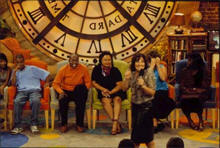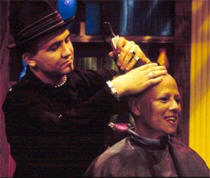 |


|
|
In his book Freaks Talk Back: Tabloid Talk Shows And Sexual Nonconformity, Gamson asks the questions: Do talk shows "give voice" to sexual and gender nonconformists? Are they a public forum where marginalized groups get to speak for themselves, or are talk shows merely exploitative? Although he makes a careful analysis of the genre, especially as it applies to sex/gender nonconformists, Gamson finds no definitive answer to the question posed above. After reading this text, one is left with a feeling of ambivalence about the positive effects of talk shows upon society and society's views of sex/gender nonconformists. At the heart of this book, where sexual meaning-making, sexual politics, and the redrawing of key social boundaries meet up, are the paradoxes of visibility that talk shows dramatize with such fury: democratization through exploitation, truths wrapped in lies, normalization through freak show. There is in fact no choice here between manipulative spectacle and democratic forum, only the puzzle of a situation in which one cannot exist without the other, and the challenge of seeing clearly what this means for a society at war with its own sexual diversity. (p. 19) Gamson explores that paradox beginning by explaining, in the first chapter, his focus on the talk show genre due to their habitual use of gay, lesbian, bisexual, and transgendered guests.
The rest of the book offers a critical investigation of the history and production processes of talk shows, the debates and conflicts over sexual morality exposed on talk shows, the deconstruction and construction of sex/gender categories in talk shows, the political battles played out on talk shows, and the "implications for the important, dangerous, and necessary changes in the cultural representation of sex and gender difference" (p. 25). The end result is a text that makes one think deeply about talk shows and about issues of representation. Is it better to be seen and sometimes misunderstood and/or exploited, or is it better to stay marginalized and erased from society? One of the aspects I appreciated most about Gamson's approach was his honesty about his social position and his repeated inclusions of himself when discussing sexual nonconformity. Gamson never professes "scientific objectivity;" instead he is quite honest about the struggles and conflicts between one's scientific and personal rationales. As host, it seems only fair to start by telling you, in a nutshell, what I really think of talk shows. As gayman, I think they're a wretched little place, emptied of so much wisdom and filled, thank God, with inadvertent camp, but they're the place most enthusiastically afforded us—a measure of our cultural value. We are taking, and are being given, much more public media space now, but because talk shows forged a path in there, and we had best understand what we can from the wretched little space where we were once honored guests. As scholarman, I think they're rich and interesting, like a funny, lively, slightly frightening room in a museum, dwell in them for a bit, think about their significance from a bunch of different angles, and you come out knowing more about the world, this current one, in which so much of how people see and feel themselves oozes into shape inside the sticky, narrow walls of commerce. Scholarman and gayman meet, for sure, in their common desire for a collective life in which, on a good day, people really take care of one another, and laugh; but it is really the restless coexistence of the two, one measured and the other lacking in the luxury of distance, one concerned with culture in general and the other just trying to survive intact within in, that juices up this book. (pp. 25–26)  As is illustrated in the lengthy passage above, Gamson has a wonderful, at times irreverent, way with words. His honesty and reflexivity add much to the depth and breadth of this work.
As is illustrated in the lengthy passage above, Gamson has a wonderful, at times irreverent, way with words. His honesty and reflexivity add much to the depth and breadth of this work.Gamson explores the many inconsistencies inherent in the talk show genre, created, in part, by the very structure of the shows which are driven by ratings. He argues that on the shows that directly focus on gays, lesbians, bisexuals and transgendered persons, the shows themselves, as well as the hosts, are usually supportive and rarely express moral condemnation (p. 113). However, he points out that this finding is contingent on the reinforcement of other social norms: The treatment of same-sex relationships as morally acceptable in fact takes place on the condition that two other norms remain conserved and supported: of gender conformity (men should look and act like "men" and women like "women") and monogamy (people should only couple in exclusive pairs). (p. 132) Therefore the positive aspects of talk shows are not the same for all queer persons. Bisexuals and transgendered persons may actually "pay the price for daytime television's progay moral cheerleading" (p. 135). Gamson admits that "Talk shows are cliché-mongering entertainment, and to suggest that they effect major paradigm shifts would be to overestimate their cultural effects; they display the radically different mostly in ways that reaffirm the normality of watchers" (p. 141). Yet that reality has to be discussed in conjunction with the positive aspects of talk shows that "throw open little cultural openings that, compare with the rest of commercial, mass-mediated popular culture, look huge" (p. 141). The reader gets the sense that although talk shows, in a perfect world, are no answer to the very real problems of stereotyping, marginalization, and isolation of sex/gender nonconformists, in our society, they function as one of the few spaces where these persons get to speak, no matter how distorted their voices may be by the medium itself. It is quickly clear. . . that on talk shows the exploitation is typically mutual . . . The struggle for self-representation is not one in which talk show guests are simple victims. They do not control the outcome, but they have a strong hand in creating it" (pp. 214-215). Gamson is to be applauded for his careful deconstruction of the paradoxes of representation in the talk show genre. This text incites the reader to a deeper appreciation of what many have dismissed as "trash," and it is written without a lot of dependence on jargon which makes it accessible to the very groups it studies. That being said however, there are a few points that I found problematic in this work. Gamson does a good job at examining issues of sexuality, gender, and class identity and the oppressions that are unique and common to them all. In glaring contrast, I found his treatment of race to be superficial, and that is a significant omission. Gamson does address race in certain areas, such as his argument that: Mainstreaming activists are rightly concerned that talk shows provide a distorted image of gay life—but then again, the image, although more socially acceptable, was no less distorted when it was only white, middle-class, gay movement movers and shakers. Lurking underneath the concern encouraged by the class dynamics of TV talk, are hints of class, racial, and regional superiority. (p. 191) I would argue that he doesn't extend these arguments far enough. Race is treated mainly as an aside, so that the images evoked by this work are of white working- and middle-class gays, lesbians, bisexuals, and transgendered persons. While the issue of how classism is played out in this genre is addressed, the complimentary notion of how racism affects the representation of sex/gender nonconformists is less deeply probed. Finally, a minor critique I had of Gamson's writing is his occasional patronizing and disparaging tone in his descriptions of certain talk show guests, hosts, and panelists. The most offensive example of this is when he is listing talk show hosts who appeared after the popularity of the Ricki Lake show and describes "schmaltz-pop singer and aptly named Carnie Wilson, who looked to me like a drag queen doing Ricki Lake before the weight loss" (p. 59). This type of witticism at the expense of others is not only unnecessary, it reeks of weight bias. I would expect a researcher who has spent so much time exploring oppression based upon sex/gender nonconformity would be less apt to buy into society's norms of beauty and femininity, much less to use the term "drag queen" as a put down. Although the critiques mentioned above are important, I believe that this book will be seen as a major text in media studies and gay, lesbian, bisexual, transgender studies as well. Gamson combines several methodologies to create a very full, rich analysis of the positive and negative affects of representations of sex/gender nonconformists on talk shows. This text was assigned in my graduate class on Media Representations of Social Problems and provoked much fruitful discussion. In closing, I believe Barry Glassner, quoted on the book cover, sums it up best when he states: "Gamson presents some of the best evidence I have seen in support of the proposition that trash can have redeeming social value." Celesta Atkins is a graduate student in Sociology at the University of Southern California focusing on race and gender and also interested in sexuality and identity formation. Review from the International Gay & Lesbian Review, ONE Institute Press, Los Angeles, CA |
 © 1997-2000 BEI
© 1997-2000 BEI
 A guest on the Ricky Lake Show
A guest on the Ricky Lake Show